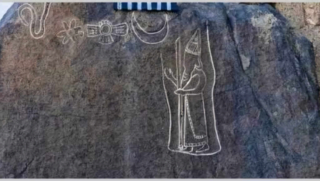The story of a carved stone in honor of a Babylonian king

The Heritage Authority in the Kingdom of Saudi Arabia announced the discovery of an artifact while they were exploring an archaeological site in the northwest of the Kingdom. While walking among the ruins in the Hail region, they found a face of basalt stone carved with the name and image of Nabonidus, the last king of the Neo-Babylonian Empire.
Nabonidus ruled the Babylonian Empire, with its legendary capital (Babylon), over most of the Arabian Peninsula, in the period from 556 BC to 539 BC, and archaeologists say that it is clear that the rock drawing was carved at some point during his reign.
In the upper part of the stone, a sculpture of Nabonidus, the ancient king, shows him holding a scepter. Above and in front of him are four symbols that have a spiritual meaning for the Babylonians: a snake, a flower, a bird, and an image of the moon in the form of a crescent. Below these sculptures there are 26 lines of cuneiform text, which Experts are currently busy decrypting it.
Representatives of the authority say that the latter is the longest cuneiform carving found anywhere on Saudi territory, and once fully decoded, it could provide some fascinating details about the life of Nabonidus and reveal more about his influence on the Arabian Peninsula in 6th century BC.
Source: websites

